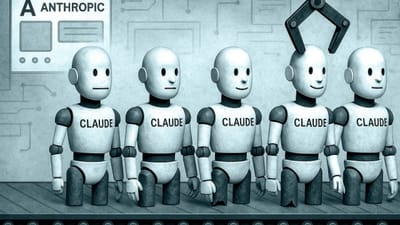On the Threshold of Instantaneous Human Obsolescence

Remember Tank loading martial arts training to Neo's mind? Instead of being inspired and making that real, we have wasted the last 26 years watching cat videos and stupid tik tok dances, and because of that, we're now on the threshold of instantaneous human obsolescence.
Job displacement, historically measured in decades is now measured in months. AI has made that acceleration exponential and corporations are all gas no brakes on a race to the bottom. And it's only Monday.
Acceleration of Technological Displacement
Look at the data. The acceleration in displacement speed across historical eras reveals a pattern that should terrify anyone paying attention:
Industrial Revolution (1760-1840): Displacement took 40-80 years. Hand weavers and lamplighters experienced multi-generational transitions that allowed communities to adapt naturally.
Electricity/Automobile Era (1880-1930): Mixed timelines from 10-80 years. Telegraph operators took 80+ years to fully disappear, while carriage makers were eliminated in just 10-15 years.
Computing Era (1950-1980): 20-30 years became the new normal. Human calculators and assembly line workers were displaced within a generation as electronic computers achieved cost-effectiveness.
Internet Era (1980-2000s): 15-25 years for most professions. Film processing and travel agents experienced significant job losses within two decades.
Mobile/Digital Era (2000s-2010s): 5-10 years for complete industry transformation. Music and video rental workers faced the fastest historical displacement as streaming services achieved rapid consumer adoption.
AI Era (2020s-): 6 months to 2 years. We've compressed centuries of historical displacement patterns into months.
Historical job transitions succeeded because they occurred over generational timelines. Workers retired while their children entered different professions. Natural workforce turnover, gradual skill adaptation, and community economic adjustment made these transitions manageable.
Modern AI displacement destroys this natural adjustment mechanism entirely.
Let's stop pretending this is normal technological progress. It isn't.
Current AI Displacement: Unprecedented Speed
ChatGPT achieved 100 million users in just 2 months¹, compared to years or decades for previous revolutionary technologies to reach mass adoption. This isn't just "fast adoption"—it's a fundamental change in how economic disruption occurs.
Content writers, illustrators, customer service representatives, and data analysts are experiencing displacement rates that compress decades of historical patterns into mere months. Where past workers had decades to retrain or transition, modern workers face displacement faster than traditional retraining systems can respond.
The economic and social implications are unprecedented, but governments and institutions are not acting fast enough. They're still operating on the old timeline assumptions.
The Corporate Acceleration Problem
Here's what makes this worse: corporations are accelerating these timelines beyond what the technology even requires. They're laying off workers at the first sign of possible displacement, not waiting for actual displacement to occur.
The 55% regret rate tells the story—many companies quietly had to rehire staff because their AI replacements weren't ready for primetime. But they're not slowing down. They're doubling down.
Most corporate retraining announcements are public relations theater while actual job elimination accelerates. The timeline mismatch reveals the fundamental inadequacy: retraining programs require 2-4 years to complete while elimination cycles occur in 6-18 months.
The math doesn't work. It never did.
What this actually means for your future
With 41% of employers planning workforce reduction due to AI within five years², the elimination cycles are now shorter than any possible retraining timeline. This isn't a problem we can train our way out of.
Anyone alive today faces potential instantaneous obsolescence as AI acceleration continues. The traditional career model—education, employment, gradual advancement—has become incompatible with technological reality.
We are witnessing the fastest occupational changes in human history, and our institutions remain structurally incapable of addressing this new paradigm.
Adjacent areas can provide temporary refuge. There is no "AI-proof" career, but retraining cycles are shorter and might provide windows of safety while you make longer-term plans.
This threshold is about the death of predictable career transitions. What took generations now happens in months, and we're all figuring out what comes next in real time.
It's time to stop pretending the old rules still apply.
It's time to start asking our employers and institutions to do better.
References
- ChatGPT sets record for fastest-growing user base, reaching 100 million users in just 2 months. Reuters. https://www.reuters.com/technology/chatgpt-sets-record-fastest-growing-user-base-analyst-note-2023-02-01/
- "41% of employers intend to downsize their workforce as AI automates certain tasks" by 2030. CNN Business - World Economic Forum. https://www.cnn.com/2025/01/08/business/ai-job-losses-by-2030-intl
Articles about UX, PM, and AI




Member discussion